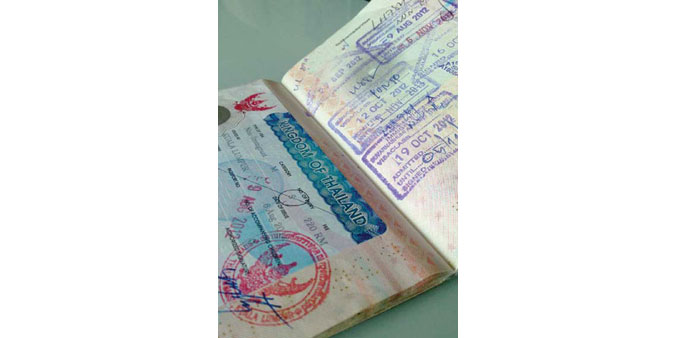Thailand needs international tourists to get its sluggish economy into gear. The weak baht and a new convenient six-month multiple-entry visa for visitors from any nation could do the trick. PICTURE: Arno Maierbrugger
By Arno Maierbrugger
Gulf Times Correspondent Bangkok
Thailand is experiencing a surge in tourist arrivals at the peak of the first high season this year. Arrivals in July 2015 rose 38% year-on-year, Tourism and Sports Minister Kobkarn Wattanavrangkul said on August 5 at a press conference in Bangkok, adding that the industry has strongly bounced back after last year’s political uncertainty and a junta taking over the political agenda, as well as due to a weakening currency.
Thailand, which was the 10th most visited country in the world in 2014 and 7th in terms of international tourism receipts, welcomed 2.64mn visitors in July. The total number of visitors in the first seven months of 2015 stood at 17.5mn, up 31.6% compared to the same period in 2014, a year which saw a military coup in May and subsequently martial law imposed for eleven months. Tourism revenue was $23.3bn between January and July 2015, up 30.6% year-on-year, according to ministry statistics. The government expects record arrivals of 30mn tourists for the whole year, generating up to $63bn in tourism revenue, as Thailand’s high tourist season peaks another time starting in November.
Arrival growth in Thailand is owing to the steadily rising number of Chinese visitors, and Malaysia and Japan also ranked among the biggest source countries in 2015, the ministry says, while European countries, as well as Russia, saw a slump in double-digit percentage figures with the fall expected to continue for the rest of the year. Thai Airways has already cancelled its flights to Moscow and Madrid earlier this year, and said will axe its Rome route in October.
The number of Middle Eastern visitors, in turn, grew strongly, which shows that the shifting focus of the Tourism Authority of Thailand (TAT) not just towards East Asia, but also the Middle East and North Africa region, is starting to pay off. There were recent steps to attract more Middle Eastern tourists, namely a stronger focus on halal food and halal tourism, the launch of a Muslim-tailored smartphone travel application for Thailand, and collaborations with three Middle East airlines by inking a $1.25mn promotional deal with Etihad Airways, as well as entering a partnership with Emirates to attract niche markets such as honeymoon, golf, medical and wellness tourists, and Gulf Air to tap new quality markets such as Oman and Jordan. Qatar Airways said it will add a second daily Airbus A380 service to its four regular Doha-Bangkok flights from September 16, while Emirates will increase its A380 service between Dubai and Bangkok to four from three daily flights using the double-decker superjumbo jet from December 1.
Qatar Airways has also launched non-stop daily flights from Doha to Phuket last October and has entered a code-share agreement with Bangkok Airways for domestic connections in Thailand.
Meanwhile, Thailand’s Prime Minister Prayuth Chan-ocha earlier this week approved a new visa type “for nationals of any country” wanting to visit Thailand in an attempt to boost tourism even further amid an otherwise alarmingly sluggish economy. The new visa, to be available from October, is a six-months multiple entry visa that will cost $142 and allow visitors to stay half a year in Thailand with just two border runs and no other hassles.
Currently, Gulf Cooperation Council citizens except Saudis are allowed to stay 30 days visa-free in Thailand (if arriving by air, 15 days if arriving overland). Saudis need to apply for a visa-on-arrival ($28) that is good for 15 days. All the aforementioned stay permits are extendable by 30 days for $54 which makes it quite complicated to stay for a longer time in Thailand and gives the new six-month visa a quite good sales proposition.

